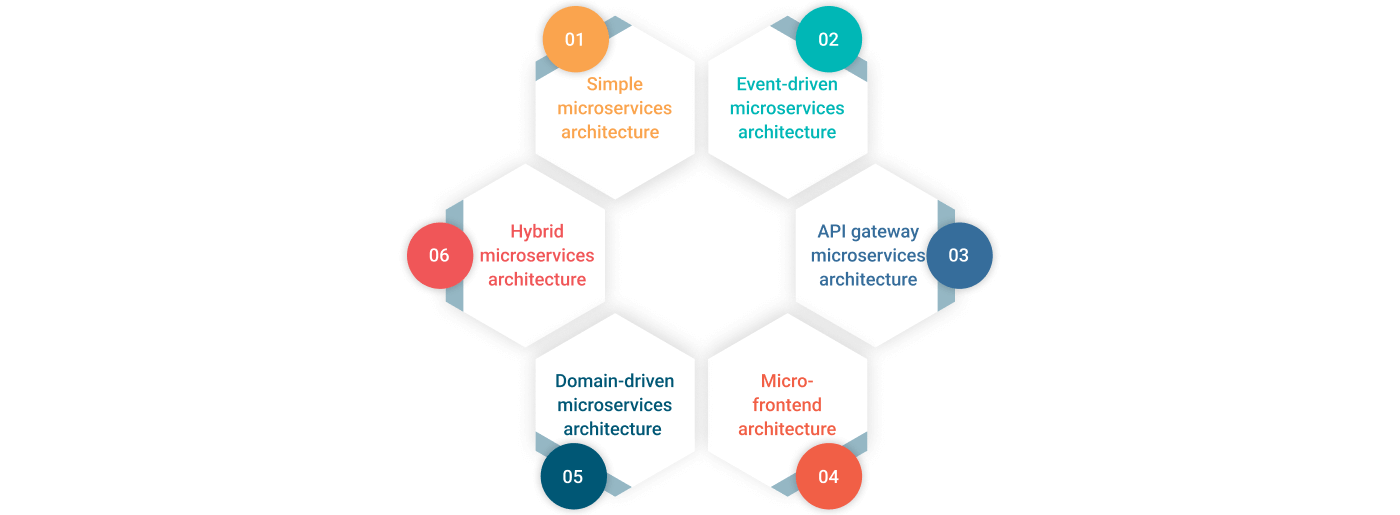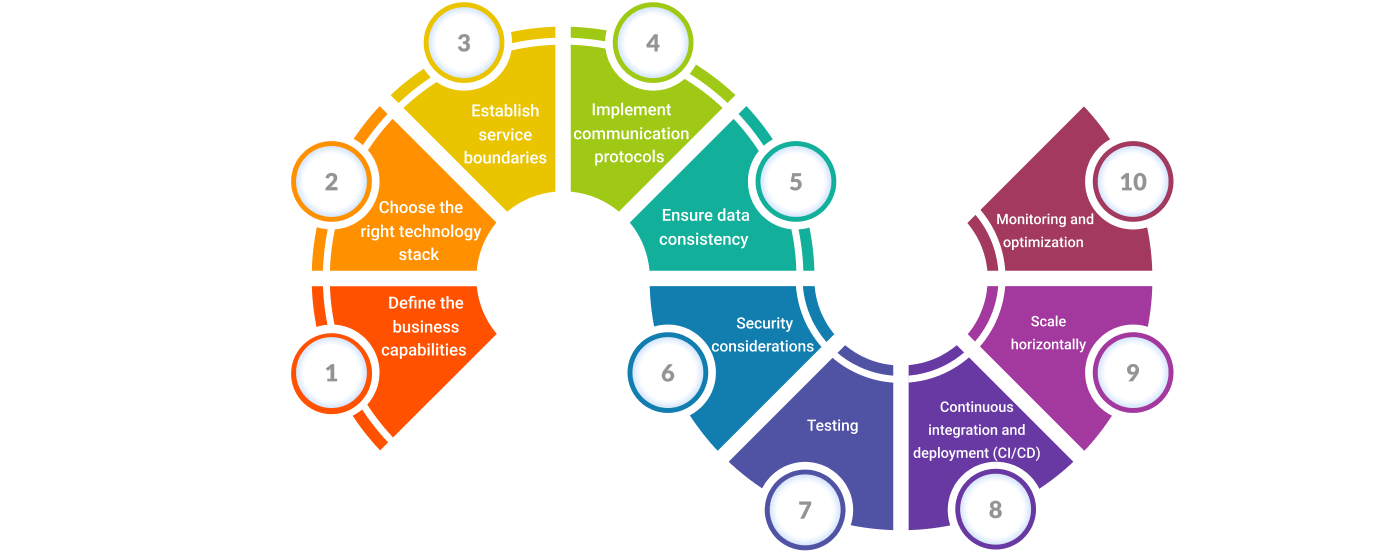 By Jophin
November 24, 2023
3 min read
By Jophin
November 24, 2023
3 min read
A Comprehensive Guide to Microservices Architecture
Developing a highly responsive application with elite functionalities might be the vision of many startups and entrepreneurs. Over the past few years, many applications have been launched, and those applications hold data in terabytes. All users of these apps will expect instant responses for the inputs, a user-friendly interface, glitch-free workflow, advanced functionalities, and more aspects. If your application needs to be extremely responsive, then the best way to achieve this is to adopt the Microservices architecture.
In the ever-evolving landscape of software development and app creation, the shift towards microservices architecture has become a defining trend among startups and developers. As businesses strive for scalability and improved development speed, microservices offer a revolutionary approach. Besides, many reputed companies also utilized microservice architecture in their apps to deliver better performance for customers.
This comprehensive guide aims to unravel what microservices architecture is, with its definition, types, notable adopters in Australia, the process of building microservices applications, and the associated benefits. Additionally, we will delve into how Fortunesoft stands as a valuable ally in the journey of adopting and implementing microservices.
Let us kickstart this guide with a basic definition.
What are Microservices architecture?
Microservices is an innovative architecture pattern to software development that structures an application as a collection of small, independent, and loosely coupled services. This service manages the database, and each service is designed to perform a specific task. These services can communicate with others through events, messages, or APIs. Adopting microservices architecture could ease the task of overall software development
Utilizing microservices architecture in your application or software allows your system to be more modular. You can develop a set of services to handle each aspect of the system, instead of creating a single large application. In addition, adopting Microservices architecture for your application will help you enhance developer productivity, scale applications independently, and make it easier to integrate new features.
Before the prominence and utilization of microservices in Australia, developers built and deployed apps as single cohesive units. Sometimes, this led to scalability bottlenecks, as every alteration to the app required rebuilding from scratch. However, Microservices architecture helped to overcome these challenges.
Top companies using Microservices in Australia
Australia is known for its thriving tech industry, which has seen a surge in the adoption of microservices architecture. Some of the top Australian companies using this architecture approach are listed below.
-
Atlassian
This company employs microservices to power its suite of collaboration tools, which allows for flexibility and rapid software development processes.
-
Afterpay
This popular buy-now-pay-later platform utilizes microservices to enhance its scalability and responsiveness, which meets the demands of a growing user base.
-
REA Group
REA Group is a prominent player in the real estate industry. They leverage microservices architecture for their digital platforms and offer a seamless user experience to the users.
Apart from these, some prominent companies out there utilize microservices for their application. They are Netflix, Amazon, Uber, eBay, Etsy, and Spotify.
Types of Microservices Architecture
Microservices architecture is not a one-size-fits-all solution. There are many types of architecture in microservices, each type comes with its own set of principles and advantages. Let us see some of the significant types.

Let us discuss these primary types of microservices architecture briefly.
1. Simple microservices architecture
Simple microservices architecture is characterized by its straightforward design, where each microservice encapsulates a specific business function. Communication between microservices typically involves lightweight protocols such as HTTP/REST. This type is ideal for smaller applications or projects where complexity needs to be minimized.
Advantages:
- Straightforward implementation and understanding.
- Easy to scale and deploy independently.
2. Event-driven microservices architecture
Event-driven microservices architecture is built around the concept of events and messages. Microservices communicate through events, which trigger actions. This type is particularly effective for real-time systems, which ensure responsiveness and scalability. Event-driven architecture promotes loose coupling and communication through asynchronous events. It might be well-suited for apps or systems requiring real-time updates.
Advantages:
- Enhanced scalability and responsiveness.
- Loose coupling allows for independent development and deployment.
3. API gateway microservices architecture
API gateway microservices architecture involves the use of a centralized API gateway to manage communication between clients and microservices. The API gateway handles tasks such as routing, composition, and protocol translation. So, it simplifies the client-side experience. You can utilize a centralized API gateway for managing external communication. In addition, it allows for authentication, authorization, and load balancing at the gateway level.
Advantages:
- Simplifies client-side interactions.
- Centralized control for security and routing.
- Enhances security, performance, and scalability.
4. Micro-frontend architecture
The micro-frontend architecture extends the microservices concept to the user interface. Each micro-frontend corresponds to a specific user interface element. This type facilitates independent development and deployment of front-end components. Frontend is divided into independent micro-frontends. Each micro-frontend is responsible for a specific UI component or feature.
Advantages:
- Decouples front-end development and promotes reusability.
- Easier maintenance and updates to specific UI elements.
- Amplifies agility, modularity, and flexibility.
5. Domain-driven microservices architecture
Domain-driven microservices architecture aligns with the principles of domain-driven design (DDD). Microservices are organized around specific business domains, which supports a deep understanding of the business and its processes. Therefore, communication patterns are tailored to business processes.
Advantages:
- Enhanced alignment with business goals.
- Clear mapping of microservices to business functionalities.
6. Hybrid microservices architecture
Hybrid microservices architecture combines elements of different types to create a customized solution that meets your specific business requirements. This approach allows you to leverage the strengths of various architectures based on the context of their applications.
Advantages:
- Adaptable to diverse application requirements.
- Can optimize for performance, scalability, and ease of development based on specific use cases.
- Offers flexibility and adaptability.
As a business owner or a CXO of the company, choosing the right type of microservices architecture is paramount. You can choose the best type based on the scale of the application, business requirements, and development team preferences. Understanding the distinctive features of each type empowers you to make informed decisions and design architectures that align with your business goals.
Next, let us see.
How to build a Microservices application?
Building a microservices application requires careful planning and execution. Here we list key steps in the development process.

Let us see them in detail.
-
Define the business capabilities
Identify the unique business capabilities or functions that your application needs to perform. Break down these capabilities into smaller, manageable services, and each should represent a specific functionality.
-
Choose the right technology stack
Select appropriate technologies for each microservice based on the specific requirements of that service. Consider factors like programming language, database, and communication protocols while picking the tech stack.
-
Establish service boundaries
Clearly define the boundaries of each microservice to ensure they are independent and have well-defined interfaces. Use domain-driven design principles to map out the relationships between microservices.
-
Implement communication protocols
Choose effective communication protocols for inter-service communication. Options include RESTful APIs, message queues (e.g., RabbitMQ, Apache Kafka), or gRPC. Furthermore, ensure that communication is asynchronous and resilient to enhance system robustness.
-
Ensure data consistency
Implement excellent strategies for maintaining data consistency across microservices. As a business owner, you can consider approaches like event sourcing, distributed transactions, or eventual consistency based on the specific needs of your application.
-
Security considerations
Enable multiple degrees of security, such as network security, authentication, and authorization. Additionally, consider securing communication between microservices using encryption and secure APIs.
-
Testing
Adopt a comprehensive testing strategy, including unit testing, integration testing, and end-to-end testing. With the help of your development team, test the resiliency of your microservices architecture by simulating failures and evaluating the response of the system.
-
Continuous integration and deployment (CI/CD)
To automate the testing and deployment procedures, incorporate CI/CD pipelines. Ensure that changes to microservices can be deployed seamlessly and quickly.
-
Scale horizontally
Design your microservices to be scalable horizontally by adding more instances to handle increased loads. Besides, leverage cloud services for dynamic scaling based on demand.
-
Monitoring and optimization
Continuously monitor the performance of your microservices and make optimizations based on real-world usage patterns. You can also utilize analytics to gain insights into user behavior and application performance.
By following these ten simple steps, you can lay a solid foundation for building a scalable and maintainable microservices application. Keep in mind that the application development journey doesn’t end with the deployment; continuous improvement is crucial for the long-term success of your microservices architecture. In addition, partnering with a trustworthy software development company in Australia is a smart move. One such reliable firm in Australia is Fortunesoft.
Why choose Fortunesoft to adopt Microservices?
Fortunesoft is a leading software development company, which stands as a valuable technical partner in the journey of adopting microservices. We have experienced IT professionals to guide businesses in understanding the nuances of microservices and assist in developing a tailored strategy for adoption. Fortunesoft specializes in providing end-to-end development services and technology solutions aligned with your unique needs.
We ensure a seamless integration of microservices into existing systems and provide ongoing support to maintain optimal performance. By choosing Fortunesoft as a trusted partner, the journey towards adopting microservices becomes not only feasible but also transformative.
Author Bio


 Facebook
Facebook Whatsapp
Whatsapp LinkedIn
LinkedIn Pinterest
Pinterest






 Start Chat
Start Chat